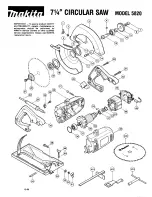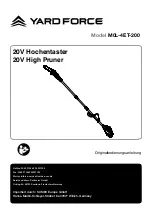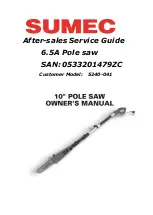
ENGLISH
33
NOTE:
Certain special cuts will require that you manually raise the
guard. See section on cutting base molding up to 88.9 mm high.
The front section of the guard is louvered for visibility while cutting.
Although the louvers dramatically reduce flying debris, they are
openings in the guard and safety glasses should be worn at all times
when viewing through the louvers.
AUTOMATIC ELECTRIC BRAKE
Your saw is equipped with an automatic electric blade brake which
stops the saw blade within 5 seconds of trigger release. This is not
adjustable.
On occasion, there may be a delay after trigger release to brake
engagement. On rare occasions, the brake may not engage at all and
the blade will coast to a stop.
If a delay or “skipping” occurs, turn the saw on and off 4 or 5 times. If
the condition persists, have the tool serviced by an authorized D
E
WALT
service center.
Always be sure the blade has stopped before removing it from the kerf.
The brake is not a substitute for guards or for ensuring your own safety
by giving the saw your complete attention.
OPERATION
Instructions for Use
WARNING:
Always observe the safety instructions and
applicable regulations.
WARNING: To reduce the risk of serious personal
injury, turn tool off and disconnect tool from power
source before making any adjustments or removing/
installing attachments or accessories.
Ensure the machine is placed to satisfy your ergonomic conditions in
terms of table height and stability. The machine site shall be chosen so
that the operator has a good overview and enough free surrounding
space around the machine that allows handling of the workpiece
without any restrictions.
To reduce effects of vibration make sure the environment temperature
is not too cold, machine and accessory is well maintained and the
workpiece size is suitable for this machine.
Prior to Operation
• Install the appropriate saw blade. Do not use excessively worn
blades. The maximum rotation speed of the tool must not exceed
that of the saw blade.
• Do not attempt to cut excessively small pieces.
• Allow the blade to cut freely. Do not force.
• Allow the motor to reach full speed before cutting.
• Make sure all locking knobs and clamp handles are tight.
• Secure the workpiece.
• Although this saw will cut wood and many nonferrous materials,
these operating instructions refer to the cutting of wood only. The
same guidelines apply to the other materials. Do not cut ferrous
(iron and steel) materials or masonry with this saw! Do not use any
abrasive discs!
• Make sure to use the kerf plate. Do not operate the machine if the
kerf slot is wider than 10 mm.
Switching On and Off (fi g. 21)
A hole (y) is provided in the on/ off switch (l) for insertion of a padlock to
lock the tool.
1. To run the tool, press the on/off switch (l).
2. To stop the tool, release the switch.
Body and Hand Position
Proper positioning of your body and hands when operating the mitre
saw will make cutting easier, more accurate and safer.
• Never place your hands near the cutting area.
• Place your hands no closer than 150 mm from the blade.
• Hold the workpiece tightly to the table and the fence when cutting.
Keep your hands in position until the switch has been released and
the blade has completely stopped.
• Always make dry runs (without power) before finish cuts so that
you can check the path of the blade.
• Do not cross your hands.
• Keep both feet firmly on the floor and maintain proper balance.
• As you move the saw arm left and right, follow it and stand slightly
to the side of the saw blade.
• Sight through the guard louvres when following a pencil line.
BASIC SAW CUTS
Vertical Straight Cross Cut (fi g. 1, 2, 23)
NOTE:
Always use 250 mm saw blades with 30 mm arbor holes to
obtain the desired cutting capacities.
1. Release the mitre lock lever (e) and depress the mitre detent (t) to
release the mitre arm.
2. Engage the mitre latch at the 0° position and tighten the mitre lever.
3. Place the wood to be cut against the fence (c, v).
4. Take hold of the operating handle (a) and depress the head lock up
release lever (cc) to release the head.
5. Press the trigger switch (l) to start the motor.
6. Depress the head to allow the blade to cut through the timber and
enter the plastic kerf plate (s).
7. After completing the cut, release the switch and wait for the saw
blade to come to a complete standstill before returning the head to
its upper rest position.
Vertical Mitre Cross-cuts (fi g. 1, 2, 24)
1. Loosen the mitre lock lever (e) and depress the mitre detent (t).
Move the head left or right to the required angle.
2. The mitre detent will automatically locate at 10º, 15º, 22.5º, 31.62º
and 45º. if any intermediate angle or 50º is required hold the head
firmly and lock by tightening the mitre lock lever.
3. Always ensure that the mitre lock lever is locked tightly before
cutting.
4. Proceed as for a vertical straight cross-cut.
WARNING:
When mitring the end of a piece of wood with
a small off-cut, position the wood to ensure that the off-
cut is to the side of the blade with the greater angle to the
fence; i.e. left mitre, off-cut to the right - right mitre, off-cut
to the left.
Bevel Cuts (fi g. 1, 2, 25)
Bevel angles can be set from 3º right to 48° left and can be cut with the
mitre arm set between zero and a maximum of 45° mitre position right
or left.
1. Loosen the left side fence clamping knob (k) and slide the upper
part of the left side fence (v) to the left as far as it will go. Loosen
the bevel clamp handle (p) and set the bevel as desired.
2. Tighten the bevel clamp handle (p) firmly.
3. Proceed as for a vertical straight cross-cut.
Quality of Cuts
The smoothness of any cut depends on a number of variables, e.g. the
material being cut. When smoothest cuts are desired for moulding and
other precision work, a sharp (60 tooth carbide) blade and a slower,
even cutting rate will produce the desired results.
WARNING:
Ensure that the material does not creep while
cutting; clamp it securely in place. Always let the blade
come to a full stop before raising the arm. If small fibres of
wood still split out at the rear of the workpiece, stick a piece
of masking tape on the wood where the cut will be made.
Saw through the tape and carefully remove tape when
finished.
Clamping the Workpiece (fi g. 3)
1. Whenever possible, clamp the wood to the saw.
2. For best results use the clamp (gg) made for use with your saw.
Clamp the workpiece to the fence whenever possible. You can
clamp to either side of the saw blade; remember to position your
clamp against a solid, flat surface of fence.
Summary of Contents for DW713
Page 1: ...www eu DW713 DW713XPS ...
Page 3: ...1 Figure 1 Figure 2 a l m dd p q j h d t e v b x cc y o ee n z aa k i r g s bb w c f u ...
Page 4: ...2 Figure 3 Figure 4 ff gg ii jj Figure 5 a m r o j hh ...
Page 5: ...3 Figure 6 Figure 10 Figure 7 Figure 9 Figure 8 cc b nn x i i nn pp oo qq rr tt v oo ...
Page 8: ...6 Figure 26 Figure 25 Figure 28 Figure 27 Figure 24 Figure 23 a v ...
Page 9: ...7 Figure 30 Figure 29 Figure 32 Figure 31 Figure 35 Figure 34 ...
Page 10: ...8 Figure 37 ...
Page 137: ...135 ...
Page 138: ...136 ...
Page 139: ...137 ...
















































